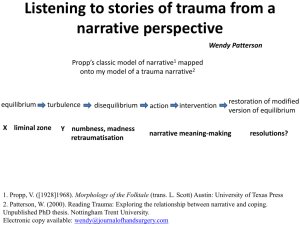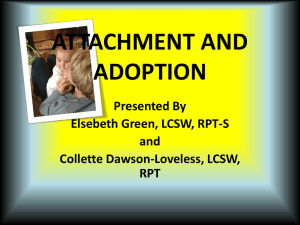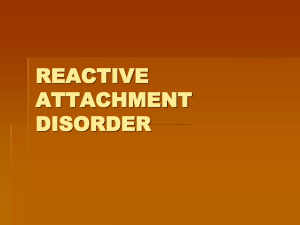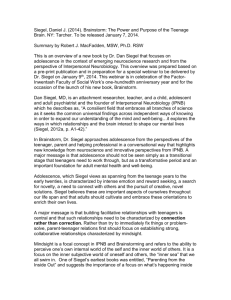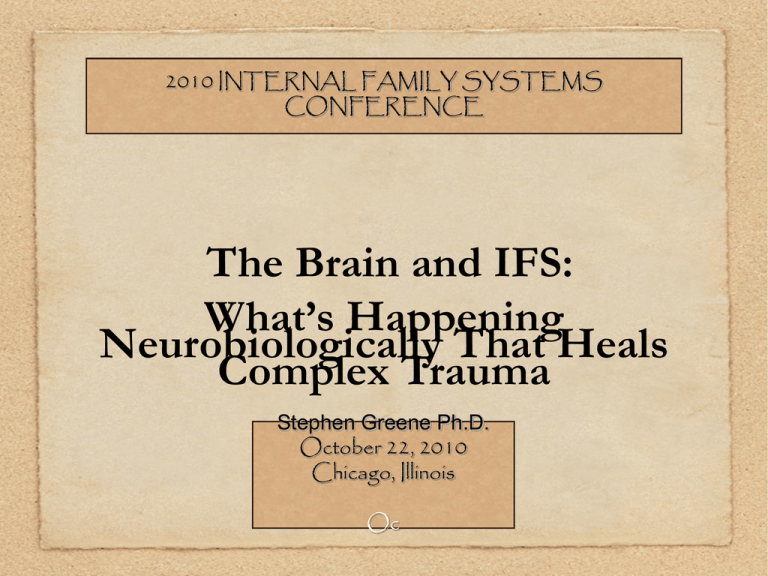
2010 INTERNAL FAMILY SYSTEMS
CONFERENCE
The Brain and IFS:
What’s Happening
Neurobiologically That Heals
Complex Trauma
Stephen Greene Ph.D.
October 22, 2010
Chicago, Illinois
Oc
Outline
Interpersonal Neurobiology (IPNB)
Complex Trauma
IFS and pulling it all together
Complex Trauma
PTSD written for DSM-III and based
on Vietnam Vets
PTSD is not all inclusive of Trauma
Stress becomes trauma when the
intensity of the frightening events
becomes unmanageable to the point of
threatening physical and psychological
integrity
Lieberman et al, 2008
Two conditions lead to traumatization:
Overwhelming Fear
Inescapable
Abuse Trauma
(Acts of Commission)
Threats of harm to self &/or others
Physical abuse/violence
Sexual abuse
Witnessing Domestic Violence
Relationship Trauma
(Acts of Omission)
Neglect
Abandonment
Loss
Repeated Separations
Simple vs. Complex Trauma
Non-interpersonal
Limited Exposure
Short Duration
Onset typically at later developmental stage
Family Support
Secure attachment
Interpersonal
Multiple Exposures: different trauma types
Longer Duration
Primary Impacts of severe childhood
abuse and neglect
Preverbal assumptions regarding self and others
Conditioned associations between abuse stimuli and
emotional distress
Implicit/Sensory memories
Narrative/autobiographical memories
Suppressed or “deep” cognitive structures
Interference in development of affect regulation/tolerance
skills
John Briere
Areas of Impairment
Physical biology of the individual
Attachment to others
Affect Regulation
Dissociation
Behavior Management
Cognitive Processing
Self-Concept
DISSOCIATION
Dissociation is a disruption in the usually integrated functions of
consciousness, memory, identity, or perception of the environment.
Certain faculties, functions, feelings, memories are split off from
immediate awareness/consciousness and compartmentalized in the
mind, where they become separate identities.
PURPOSE: way out of intolerable or psychologically incongruous
situation
barrier to keep painful events / memories out of awareness
analgesia to prevent feeling pain
escape from experiencing event
survival method used by children
“Escape when there is no escape”
Other Risks Associated with
Complex Trauma
•
At higher risk for re-victimization
Lifelong risk of interpersonal
attachment problems
INTERPERSONA
L
NEUROBIOLOG
Y
(IPNB)
Daniel Siegel M.D.
IPNB
An interdisciplinary view of human
experiences that draws on over a dozen
branches of science to find the consilient
findings across various perspectives to
create a framework for understanding the
development of our subjective and
interpersonal lives.
Daniel Siegel - The Developing Mind
Research from:
neuroscience, attachment,
memory,narrative,wisdom,emotion,
perception,attention, learning, & trauma
Basic Tenets of IPNB
The Mind is a process that monitors and
regulates the flow of energy and information
The Brain is the extended nervous system
throughout the body that is the mechanism
through which the energy and information
flow
Relationships are where the energy and
information are shared
Mind
Brain
Triangle of Wellbeing and Resilience
Relationships
Mind
The Mind DEVELOPS as the
Genetically Programmed Maturation of the
Nervous System is Shaped by Ongoing
Experience.
Mindsight is the ability for the human mind
to see itself.
It is a powerful lens through which we can
understand our inner lives with more
clarity, transform the brain, and enhance
our relationships with others.
Dr. Dan Siegel
IPNB: Well-Being
A working definition of Well-Being:
A system that connects differentiated elements into
a functional whole = an INTEGRATED System
When a system moves toward integration it is
achieving a movement toward maximizing
“COMPLEXITY.”
Emergence is the way complex
systems and patterns arise out of
a multiplicity of relatively simple
interactions.
Emergence is central to the theories of
integrative levels (Integration) and of
complex systems.
Complexity Theory
Principles
1) Complex systems have
multiple components that are
capable of becoming chaotic
2) the system is open to outside
influences
Complexity Theory
Principles (cont.)
3) complex systems are
capable of self organization
Complexity Theory
Principles (cont.)
4)Integrated Complex systems are FACES
Flexible
Adaptive
Coherent
Energized
Stable
Complexity Theory
Principles (cont.)
5. Over time complex systems either move
toward more integration (FACES) or less
integration (chaotic &/or rigid)
More Integrated Complex systems are FACES
over time:
Flexible
Adaptive
Coherent
Energized
Stable
Less integrated complex systems over
time are Rigid...Chaotic...or both
The River of Integration
Daniel Siegel
Chaos
intrusive thoughts
memories
hallucinations
worries
preoccupations
impulsive behavior and thoughts that distract
the mind
differentiation but no linkage
Rigidity
shutdown
disconnected from body
unmotivated
depressed
repeated thoughts of obsessive nature
not able to adapt
total linkage but no differentiation
IPNB: Well-Being (cont.)
An Integrated system is Flexible, Adaptive, Energetic,
Coherent, Stable (FACES)
Brain’s that are not integrated are either Rigid, Chaotic
or both
All diagnoses are either Rigid or Chaotic or Both
Daniel Siegel
Triune Brain
Brain: Some General Principles
Brain’s # 1 job is survival
Hierarchical
Bottom up development
Right-H > Left H > Frontal Lobe
Brain is the social organ of the body
Brain: Some General Principles
Memory embeds prior experiences in neural
connections in the brain.
The brain is an associational organ and matches
present firing patterns with those of the past.
The brain is an anticipation machine - linking the
present with what it expects in the future based
on experiences in the past.
The Brain is a Social Organ
The structure and function of the brain is to
engage with other people, other brains, in
the shaping of its development over time and
in shaping its activity in the present.
Neuroplasticity
Experience (Neural Activation) shapes
connections in the brain via Synapse
Formation (Synaptogenesis) and new
Neuronal Growth
Neuroceptive State of
Safety
when we are relaxed and safe it allows the system to
relax and the whole being becomes receptive to
interactions with others
our challenge is to create an interpersonal state of
safety so neuroplasticity can be enhanced
States - wired neural networks that have
been repeatedly activated together and shift
relatively quickly
Traits - neural states that have been
repeatedly activated together, occur
automatically, out of conscious control
“Neurons that fire together, wire together”
Integration
Taking differentiated neural systems
and linking them into a functional whole
Integration results from attuned
communications/interactions
Differentiation &
Linkage = Integration
Complex systems maximize complexity by
increasing linkages of differentiated
components
Middle PreFrontal Cortex
Daniel Siegel
The CentralPrefrontal
Role of the
Integrating
Middle
Cortex:
Bodily Regulation
Attuned Communication
Emotional Balance
Flexibility
Fear Extinction
Empathy
Insight
Morality
Intuition
Daniel Siegel
L-H
R-H
brain development bottom up
Right - Hemisphere
Holistic, gestalt of the world
nonverbal signals/communication (sends and perceives)
represents things as they are, describes the world,
specializes in an integrated map of the body
autobiographical memory
ability to create images of our own and other minds (empathy
and insight)
stress reduction
more R-H we tend to withdraw from the world; less
comfortable affective states
Left - Hemisphere
linguistic communication
linear
logical
explains the world, looks for cause and effect relationships
explicit factual memory
more positive affective states
if more L-H more approach states
MEMORY
TWO LAYERS OF MEMORY
IMPLICIT
NARRATIVE/EXPLICIT
Memory - Implicit
aspects of experience are stored in
unconscious, right brain, and body:
perceptions, thoughts, emotions, behaviors,
sensations and body reactions
Implicit/sensory memories
aspects of experience are stored in unconscious,
right brain, and body: perceptions, thoughts,
emotions, behaviors, sensations and body
reactions
abuse is encoded as sensory vs. verbal and
autobiographical
if preverbal it is therefor non-narrative &
sensorimotor
John Briere
Memory Explicit/Narrative
Factual - the details of what occurred
Autobiographical- sense of the self in the
memory: (2 kinds)
“observer” & “participant”
Narrative/autobiographical memories
explicit verbally mediated memory is most aversive
because it triggers associated non-verbal feelings,
implicit/sensory memories and abuse related
schema
John Briere
Hippocampus
integrates implicit aspects of
episode/memory into explicit, integrated and
connected memory of episode
shuts down when overwhelmed with
neurochemicals(adrenalin and cortisol),
dissociating, or not paying attention
flashbacks are because H is blocked from
doing its integrative function with traumatic
memory
TRAUMATIC MEMORY
Inflexible
Without context
Fragmented / dissociated
Autistic
ANS Hyperarousal
Sensory-motor / non-verbal
Developmental context in which
Trauma occurred
Somatic presentation
Regressed re-enactments outside of
conscious awareness
NARRATIVE MEMORY
Flexible
Contextual
Integrated
Relational
Minimal arousal
Symbolic / verbal
Telling a story within a Relationship
Needs core sense of SELF and
RELATIONSHIP SKILLS
Conditioned associations between
abuse stimuli and emotional distress
Classically conditioned associations between abuse stimuli &
negative emotion
CER’s become embedded into “fear structure” (neural
networks) causing distress when triggered;
can generalize to relationships involving intimacy, closeness,
vulnerability
no Autobiographical memories but simple associations...not
remembered but evoked (i.e., raise hand >> flinch)
John Briere
Suppressed or “deep” cognitive
structures
Negative and distress producing cognitions
are actively suppressed to decrease
dysphoria
When deep thoughts triggered such that
they influence other thoughts or motivate
behavior = deep cognitive activation
John Briere
Priming
an Implicit (unconscious) process that
activates the nervous system to be ready
to respond to what it predicts/expects
to occur
(Mind)
(Brain)
The Nine Domains of Integration
Consciousness
Bilateral
Vertical
Memory
Narrative
State
Interpersonal
Temporal
Transpirational
“An integrated brain comes from
integrated interactions with an
integrated brain”
Temperament and Attachment
Temperament
•
•
•
An inborn feature of the child (not only genetic)
Inborn predisposition of the nervous system
May
have with
lifelong
impact that is influenced by experience –
especially
caregivers
Attachment
•
•
•
The relationship of the child to the caregiver over time
Research has shown attachment shapes the developing mind
Attachment impacts self-regulatory circuits
Daniel Siegel
Chess and Thomas’ Nine Aspects of Parental Report of
Temperament: Matching
Activity Level (the motor
activity)
Rhythmicity (regularity of
functions)
Approach (positive response
to new stimuli vs.
withdrawal)
Adaptability (ease with which
responses are modified)
Threshold of Responsiveness
(sensitivity level)
Intensity of Reaction (the general
energy level of a response)
Quality of Mood (the intensity
and nature of emotional
responsiveness)
Distractablity (responsiveness to
extraneous stimuli altering
ongoing behavior)
Attention span/persistence
(vigilance in attending to task)
Daniel Siegel
if insecure become prisoner of temperament
if secure become comfortable in your own
skin
Attachment
We are biologically wired to attach for
survival
secure attachment is significant factor in
preventing PTSD
extremely high correlation between parent’s
and child’s attachment categories
Attachment (cont.)
actual experiences the infant has with the
caregiver will shape how the child adapts to
life with that caregiver (attachment category)
How Attachment develops
Resonance
Attunement
Right brain to Right brain
Synchrony>>>dysynchrony>>>synchrony
(recovery)
Interactive repair: the dyadic regulatory
mechanism for recovering from negative
affective ruptures of the attachment bond. The
“good-enough” caregiver is responsible for the
reparation of dyadic misattunements and
ruptures in the attachment bond of emotional
communication. Dyad moves from positive to
negative back to positive affect
The Resonance System
Daniel Siegel
ISO - Internal State of
the Other
NOTO - Narrative of the
Other
Resonating with another:
receiving another person fully, allowing
your own internal shifts to happen,
then sharing back with the other a bit
of yourself and a bit of how you were
changed by the other
Contingent communication
1. perceive something is being communicated
2. accurately perceive and understand what
is being communicated
3. respond in an appropriate and timely
manner
WE
the experience of “WE” occurs when an
integrated system responds with contingent
communication via the resonance system...I
perceive you (i take you in (ISO/NOTO)...I
accurately interpret your needs...I respond in a
timely and appropriate way...you perceive my
response and take it in = “WE” experience
WE
(cont.)
If the baby cries ---> the father cries =
differentiated
linked but not
If baby cries ---> father has no response =
differentiated but not linked
If baby cries and father perceives it, accurately
interprets it, responds in appropriate and timely way =
integrated response = WE experience
Outcomes of attachment
Attachment Category
Internalized beliefs
Affect Regulation
Attachment
Category/Types
Secure
Insecure - Anxious Dependent
Avoidant
Disorganized
Attachment I: Relationships in Research (ISS Infant Strange Situation) Studies
Relationship Type
Secure
Avoidant
Anxious Ambivalent
Disorganized
Parenting Behavior
Responsive, Consistent
Rejecting, Distant
Daniel Siegel
Attachment II: Adults Making Sense of
Their Lives
(Adult Attachment Interview)
Adult Narrative...............
>> Child Attachment
F - Free/Secure .............
............Secure
Dis - Dismissing..............
............Avoidant
E - Entangled, Preoccupied.. ............Anxious
U - Unresolved Trauma or Grief.. .......Disorganized
Daniel Siegel
Internalized Beliefs
About Themselves
About Others (Relationships)
About the World
Preverbal assumptions regarding self
and others
Internal representations of Self and others
Child makes inferences based on how they
are treated
Intrinsically unacceptable or malignant
deserving of punishment & neglect, helpless,
inadequate, weak
Others are inherently dangerous, rejecting,
unavailable
John Briere
Affect Regulation
Auto
Interactive
Affect Regulation
Auto Regulation (Avoidant)
Interactive Regulation (Insecure)
Disorganized attached children are not able to
be regulated (soothed) by themselves or
others
Self/Affect Regulation
part of Stress Response System
develops via repetitive exposure to
controllable challenges
moderate predictable stress in a responsive
controllable environment leads to resilience
unpredictable and/or sever stress can lead
to a hyperactive stress response system and
a host of problems
Interference in development of
affect regulation/tolerance skills
Person’s capacity to control and tolerate strong (especially
negative) affect, without resorting to avoidance strategies
(i.e., dissociation, substance abuse, or other external reducing
behavior - sex, self-harm, etc.)
John Briere
Affect regulation is not just the
dampening of negative emotion;
also an amplification of positive
emotion
“Therapeutic Window” - Briere
Window Of Tolerance Early Treatment
Chaos
------------------------ -------------------
Optimal
Zone of
Functioning
Rigidity
S. Greene
2010
Window Of Tolerance
Early Treatment
Chaos
----------------------------
Optimal
Zone of
- - - - - - - - - - - - - - - - - - - - - - - - - - - - Functioning
Rigidity
Window Of Tolerance
Later In Treatment
--------------------------
Chaos
Optimal
Zone of
Functioning
---------------------------
Rigidity
S. Greene 2010
Safe contingent relationships promote
integration....
Trauma blocks integration
Self-Trauma Model
John Briere, Ph.D.
Summary of the self-trauma
Model
early chronic trauma experiences (commission and/or
omission) cause difficulties in adaptive skills (self
development, regulation, etc.) and the brain’s natural
process of healing (exposure, arousal, disparity,
desensitization) are derailed due to the very narrow
therapeutic window, which results in chronic triggering
without any healing (integration)
Exposure
Disparity
Cognitive Restructuring
Habituation
Treatment
Treatment involves increasing the Window of Tolerance
to allow the brain to
1. bring up traumatic material
2. not get overwhelmed
3. have a different experience while remembering, feeling,
talking about the trauma
4. developing a narrative that makes sense with
integrating of Implicit memories/material
Exploration vs. Consolidation
Exploratory interventions invite the client to verbally
examine (& therefor Implicitly re-experience) material
related to trauma history
the survivor, in context of relatively safety attempts
something new (i.e., thinking of something not previously
fully considered or feeling something previously not fully
experienced)
Consolidation is less concerned with
exposure or processing than with safety and
foundation
Client is not being asked to avoid trauma
states, but rather to more fully anchor to
strengthen challenged self capacities (i.e.,
keeping within the Window of Tolerance,
honor limit setting for safety and security)
Potential barriers/contraindications to mindfulness
interventions for trauma
Limited capacity to self-reflect
Insufficient initial self-compassion reduces experience of disparity/safety,
increases accessibility of self-hatred
Experiencing relaxation, “letting go” as loss of control –paradoxical anxiety
Overwhelming intrusions with decreased avoidance
Dissociation/avoidance misperceived as meditation
Pseudo-samadhi
In many cases, initial focus is on building affect skills, self-compassion, cognitive
understanding
Meditation/contemplative activities that initially prize grounding and self-acceptance over free attention
John Briere
Inspire to Rewire


